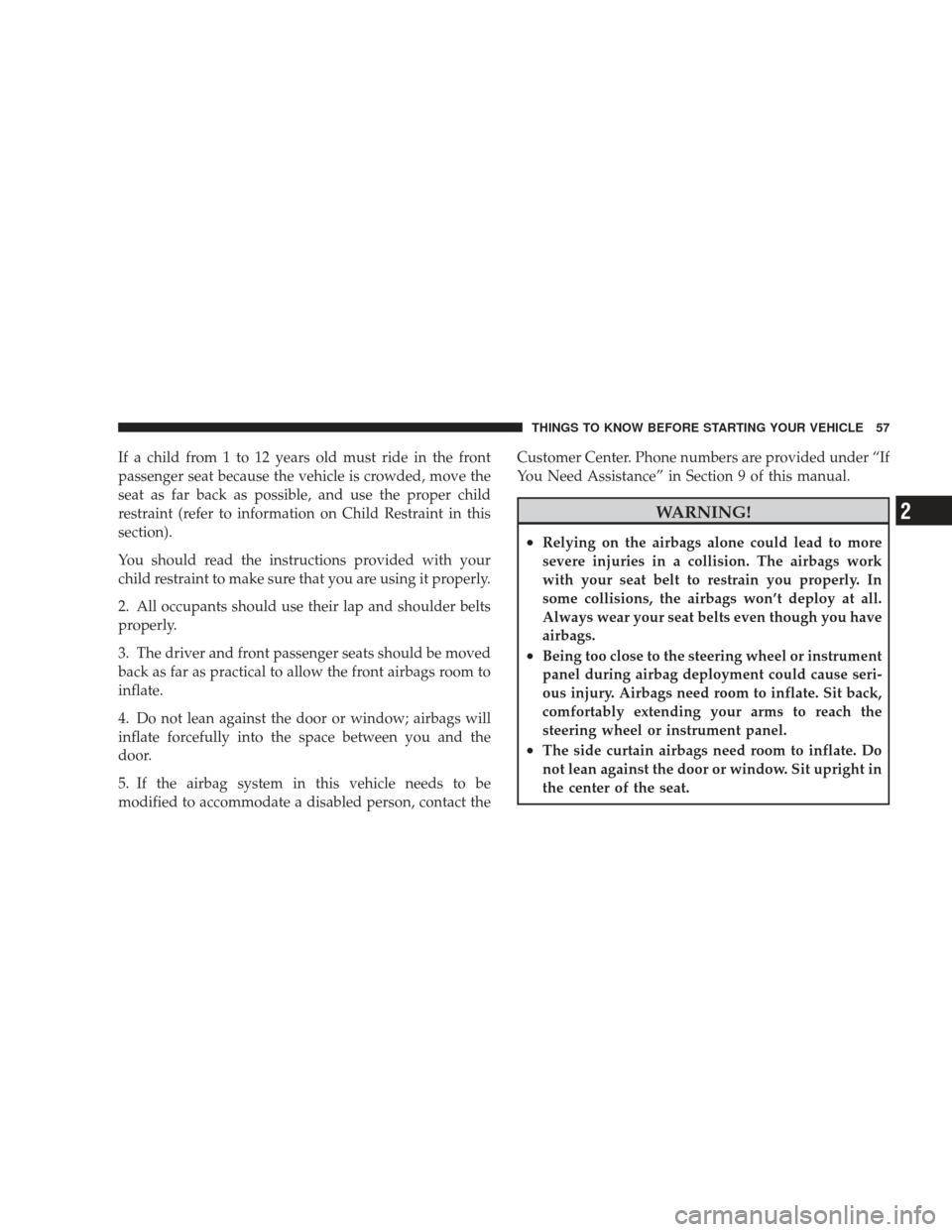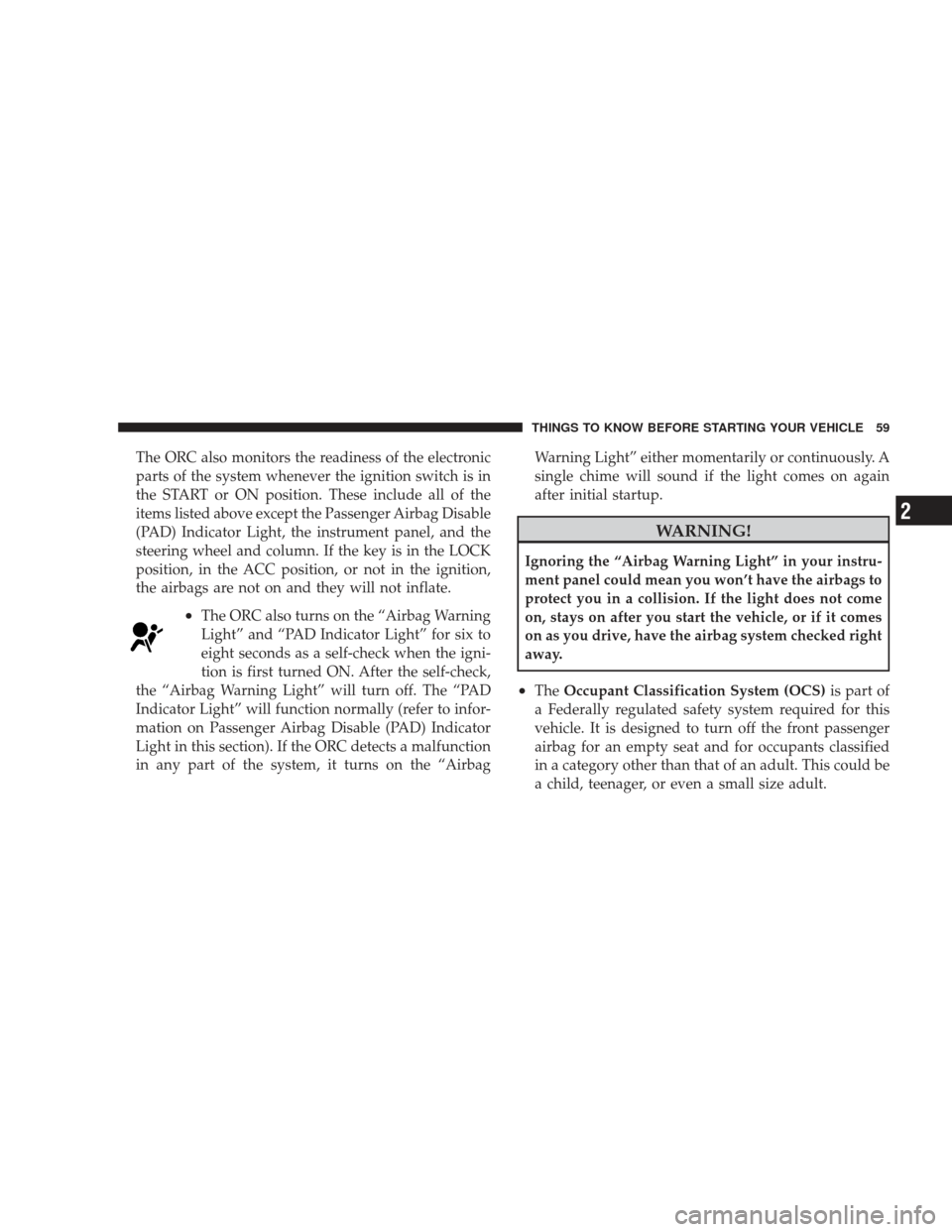Page 3 of 506
TABLE OF CONTENTSSECTIONPAGE
1INTRODUCTION.............................................................3
2THINGS TO KNOW BEFORE STARTING YOUR VEHICLE...............................9
3UNDERSTANDING THE FEATURES OF YOUR VEHICLE...............................85
4UNDERSTANDING YOUR INSTRUMENT PANEL................................... 197
5STARTING AND OPERATING................................................. 287
6WHAT TO DO IN EMERGENCIES...............................................393
7MAINTAINING YOUR VEHICLE............................................... 407
8MAINTENANCE SCHEDULES.................................................. 453
9IF YOU NEED CONSUMER ASSISTANCE..........................................469
10INDEX....................................................................479
1
2
3
4
5
6
7
8
9
10
Page 9 of 506
WARNINGS AND CAUTIONS
This Owner’s Manual containsWARNINGSagainst op-
erating procedures that could result in an accident or
bodily injury. It also contains CAUTIONSagainst proce-
dures that could result in damage to your vehicle. If you
do not read this entire manual, you may miss important
information. Observe all Warnings and Cautions.
VEHICLE IDENTIFICATION NUMBER
The Vehicle Identification Number (VIN) is found on the
left front corner of the instrument panel. The VIN is
visible from outside of the vehicle through the wind-
shield. This number also is stamped into the right front
door sill (under the molding) and appears on the Auto-
mobile Information Disclosure Label affixed to a window
on your vehicle, the vehicle registration, and the title. NOTE:
It is illegal to remove the VIN.
Vehicle Identification Number
INTRODUCTION 7
1
Page 55 of 506
Driver and Front Passenger Supplemental
Restraint System (SRS) - Airbags
This vehicle has airbags for both the driver and front
passenger as a supplement to the seat belt restraint
systems. The driver’s airbag is mounted in the steering
wheel. The passenger’s front airbag is mounted in the
instrument panel, above the glove compartment. The
words SRS AIRBAG are embossed on the airbag covers.
1 — Driver Airbag
2 — Passenger AirbagTHINGS TO KNOW BEFORE STARTING YOUR VEHICLE 53
2
Page 59 of 506

If a child from 1 to 12 years old must ride in the front
passenger seat because the vehicle is crowded, move the
seat as far back as possible, and use the proper child
restraint (refer to information on Child Restraint in this
section).
You should read the instructions provided with your
child restraint to make sure that you are using it properly.
2. All occupants should use their lap and shoulder belts
properly.
3. The driver and front passenger seats should be moved
back as far as practical to allow the front airbags room to
inflate.
4. Do not lean against the door or window; airbags will
inflate forcefully into the space between you and the
door.
5. If the airbag system in this vehicle needs to be
modified to accommodate a disabled person, contact theCustomer Center. Phone numbers are provided under “If
You Need Assistance” in Section 9 of this manual.
WARNING!
•Relying on the airbags alone could lead to more
severe injuries in a collision. The airbags work
with your seat belt to restrain you properly. In
some collisions, the airbags won’t deploy at all.
Always wear your seat belts even though you have
airbags.
•Being too close to the steering wheel or instrument
panel during airbag deployment could cause seri-
ous injury. Airbags need room to inflate. Sit back,
comfortably extending your arms to reach the
steering wheel or instrument panel.
•The side curtain airbags need room to inflate. Do
not lean against the door or window. Sit upright in
the center of the seat.
THINGS TO KNOW BEFORE STARTING YOUR VEHICLE 57
2
Page 60 of 506

Airbag System Components
The airbag system consists of the following:
•Occupant Restraint Controller (ORC)
•Airbag Warning Light
•Driver Airbag
•Front Passenger Airbag
•Side Curtain Airbags above Side Windows
•Side Remote Acceleration Sensors
•Steering Wheel and Column
•Instrument Panel
•Interconnecting Wiring
•Front Acceleration Sensors
•Front Passenger Seat Belt Pretensioner and Retractor
— If Equipped
•Occupant Classification System (OCS) — Front Pas-
senger Seat Only
�Occupant Classification Module (OCM)
�Passenger Airbag Disable (PAD) Indicator Light
�Weight Sensors
How the Airbag System Works
•
TheOccupant Restraint Controller (ORC) determines
if a frontal, side, or rollover collision is severe enough
to require the airbags to inflate. The front airbag
inflators are designed to provide different rates of
airbag inflation from direction provided by the ORC.
The ORC may also modify the rate of inflation based
on the occupant size. The ORC receives this data from
the Occupant Classification Module (OCM). The ORC
will detect rollovers, but not rear impacts.
58 THINGS TO KNOW BEFORE STARTING YOUR VEHICLE
Page 61 of 506

The ORC also monitors the readiness of the electronic
parts of the system whenever the ignition switch is in
the START or ON position. These include all of the
items listed above except the Passenger Airbag Disable
(PAD) Indicator Light, the instrument panel, and the
steering wheel and column. If the key is in the LOCK
position, in the ACC position, or not in the ignition,
the airbags are not on and they will not inflate.
•The ORC also turns on the “Airbag Warning
Light” and “PAD Indicator Light” for six to
eight seconds as a self-check when the igni-
tion is first turned ON. After the self-check,
the “Airbag Warning Light” will turn off. The “PAD
Indicator Light” will function normally (refer to infor-
mation on Passenger Airbag Disable (PAD) Indicator
Light in this section). If the ORC detects a malfunction
in any part of the system, it turns on the “Airbag Warning Light” either momentarily or continuously. A
single chime will sound if the light comes on again
after initial startup.
WARNING!
Ignoring the “Airbag Warning Light” in your instru-
ment panel could mean you won’t have the airbags to
protect you in a collision. If the light does not come
on, stays on after you start the vehicle, or if it comes
on as you drive, have the airbag system checked right
away.
•The
Occupant Classification System (OCS) is part of
a Federally regulated safety system required for this
vehicle. It is designed to turn off the front passenger
airbag for an empty seat and for occupants classified
in a category other than that of an adult. This could be
a child, teenager, or even a small size adult.
THINGS TO KNOW BEFORE STARTING YOUR VEHICLE 59
2
Page 62 of 506
NOTE:Children 12 years and younger should always
ride buckled up in a rear seat in an appropriate child
restraint.
•The Passenger Airbag Disable (PAD) Indicator Light
(an amber light located in the center of the instrument
panel) tells the driver and front passenger when the
front passenger airbag is turned off. The “PAD Indi-
cator Light” illuminates the words �PASS AIR BAG
OFF� to show that the passenger airbag will not inflate
during a collision requiring airbags. When the front
passenger seat is empty or when very light objects are
placed on the seat, the passenger airbag will not inflate
even though the “PAD Indicator Light” is not illumi-
nated.
Indicator Light Location
60 THINGS TO KNOW BEFORE STARTING YOUR VEHICLE
Page 64 of 506

will cause the system to turn the airbag on. In this case,
the OCS has classified the occupant of the seat as an
adult. An adult occupant needs to sit in a normal position
(with their feet on or near the floor) in order to be
properly classified. Reclining the seat back too far may
change how an occupant is classified by the OCS.
Drivers and adult passengers should verify that the
“PAD Indicator Light” is not illuminated when an adult
is riding in the front passenger seat. If an adult occu-
pant’s weight is transferred to another part of the vehicle
(like the door or instrument panel), the weight sensors in
the seat may not properly classify the occupant. Objects
lodged under the seat or between the seat and the center
console can prevent the occupant’s weight from being
measured properly and may result in the occupant being
improperly classified. Ensure that the front passenger
seatback does not touch anything placed on the back seatbecause this can also affect occupant classification. Also,
if you fold down the rear seat check to be sure it doesn’t
touch the front passenger seat.
If the front passenger seat is damaged in any way, it
should only be serviced by an authorized dealer. If the
seat is removed (or even if the seat attachment bolts are
loosened or tightened in any way), take the vehicle to an
authorized dealer.
If there is a fault present in the OCS, the “Airbag Warning
Light” (a red light located in the center of the instrument
cluster directly in front of the driver) will be turned on.
This indicates that you should take the vehicle to an
authorized dealer. The “Airbag Warning Light” is turned
on whenever there is a fault that can affect the operation
of the airbag system. If there is a fault present in the OCS,
both the “PAD Indicator Light” and the “Airbag Warning
Light” are illuminated to show that the passenger airbag
is turned off until the fault is cleared. If an object is
62 THINGS TO KNOW BEFORE STARTING YOUR VEHICLE